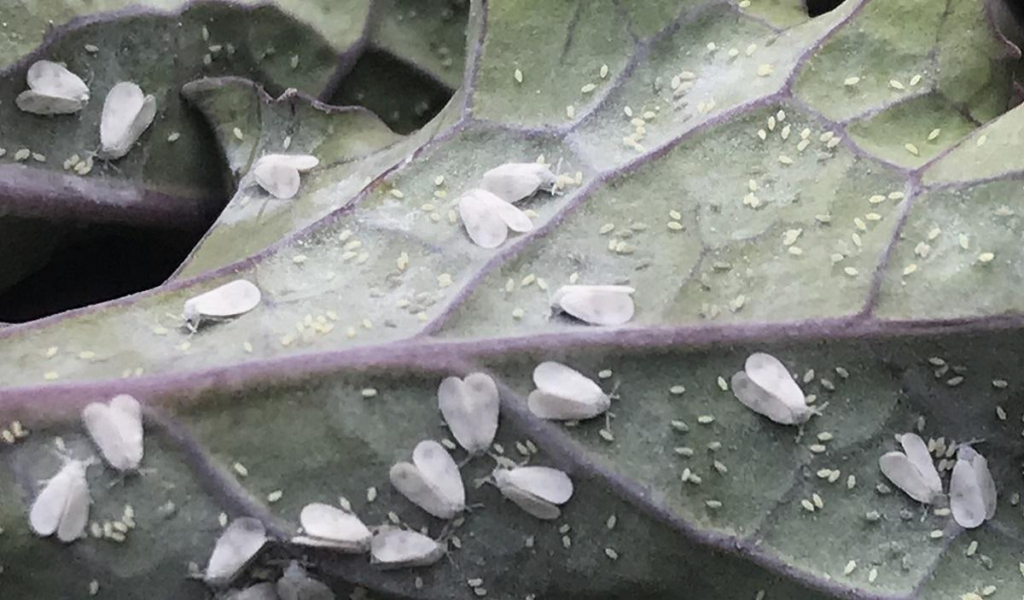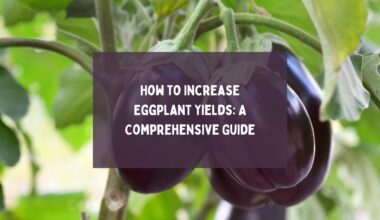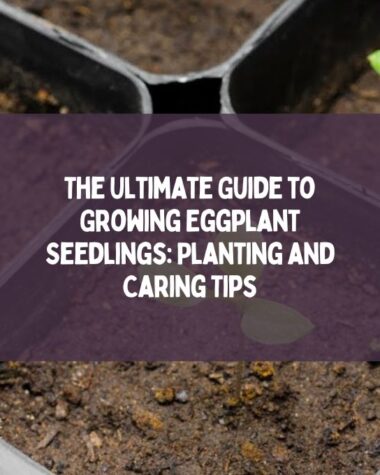Eggplants, also known as aubergines, are versatile and delicious vegetables commonly used in various cuisines around the world. However, like any other plant, eggplants are susceptible to pests that can damage their growth and productivity.
In this comprehensive article, we will explore the different pests that can infest eggplants and provide valuable insights on how to identify, prevent, and manage these pesky invaders. From aphids to caterpillars, we’ve got you covered!
So let’s dive into the world of eggplant pests and learn how to protect your precious crop.
12 Eggplant Pests And Their Treatments

1. Aphids
Aphids are small insects that belong to the order Hemiptera. They are commonly found on eggplants and other plants, where they feed on the sap. Aphids can vary in color, including green, yellow, black, or brown.
Identification
To identify aphids on eggplants, look for clusters of small, soft-bodied insects on the undersides of the leaves. They often congregate in large numbers. Aphids can also leave behind a sticky substance called honeydew, which can attract ants and promote the growth of sooty mold.
Aphids Impact on eggplants
Aphids can cause damage to eggplants by feeding on the sap, which leads to stunted growth, yellowing leaves, and distorted foliage. They can also transmit plant viruses.
Treatments
Encouraging natural predators like ladybugs and lacewings can help reduce aphid populations. Spraying eggplants with a forceful stream of water can dislodge aphids. Insecticidal soap, available at garden centers, can also be used to control aphids.
Related Reading
- How to Grow Eggplant on a Trellis?
- Common Reasons Why Your Eggplants Are Not Growing: Tips and Solutions
- Top 5 Eggplant Growing Problems (and How to Fix Them)
- Eggplant Water Requirements: How Much Water Do Eggplants Need?
2. Spider Mites

Spider mites are tiny pests that belong to the family Tetranychidae. They are not actually insects but are closely related to spiders. Spider mites can infest eggplants and other plants, causing significant damage.
Identification
To detect spider mite infestation, look for signs such as stippled yellowing leaves, fine webbing, and tiny moving dots on the undersides of leaves.
Spider mites impact on eggplants
Spider mites can have harmful effects on eggplants by sucking out the plant sap, which leads to discoloration, wilting, and eventually the death of the leaves. Severe infestations can weaken the plants and reduce their overall vigor and productivity.
Treatments
Combating spider mites requires effective strategies such as increasing humidity, introducing predatory mites that feed on spider mites, or applying insecticidal soap or neem oil to control their populations.
3. Flea Beetles
Flea beetles are small, shiny beetles that belong to the Chrysomelidae family. They can be a nuisance for eggplant growers.
Identification
To identify signs of flea beetle damage, inspect eggplant leaves for small, irregular holes, especially around the lower portions. Flea beetles feed on the foliage, leaving behind a series of tiny pits. If disturbed, these beetles can quickly jump or fly away.
Flea beetles Impact on eggplants
Flea beetles can have a significant impact on eggplants. Their feeding can cause damage to the leaves, leading to a reduction in photosynthetic capacity and overall plant vigor. Severe infestations can result in defoliation, stunted growth, and a decline in the overall health of the plants.
Treatments
Managing flea beetles organically involves strategies such as using floating row covers to physically prevent their access to the plants, employing trap crops to divert them, and applying diatomaceous earth, a natural substance that deters flea beetles.
4. Cabbage Loppers
Cabbage loopers are green caterpillars that belong to the moth family Noctuidae. They are named for their characteristic looping movement when crawling. Cabbage loopers can be a threat to eggplant crops.
Identification
To spot cabbage looper infestations, look for irregularly shaped holes on eggplant leaves, skeletonized foliage, and dark green grass (excrement) on the leaves. The caterpillars may also be visible as they move and feed.
Cabbage loppers Impact on eggplants
Cabbage loopers can have negative consequences for eggplants. They can quickly defoliate the plants, compromising their ability to photosynthesize and produce energy. Severe infestations can weaken the plants, reduce yield, and make them more susceptible to other pests and diseases.
Treatments
Controlling cabbage loopers with environmentally friendly techniques involves methods such as handpicking the caterpillars, using biological controls like parasitic wasps or Bacillus thuringiensis (Bt), and applying organic insecticides such as spinosad or pyrethrin.
5. Cutworms

Cutworms are caterpillars that belong to the Noctuidae family. They are known for their habit of cutting down young seedlings at the base, hence the name “cutworms.” These pests can pose a threat to eggplants and other crops.
Identification
Indications of cutworm presence include seedlings being severed near ground level, wilted or toppled plants, and the presence of cutworms themselves in the soil or near the damaged plants.
Cutworms Impacts on plants
Cutworms can cause destructive outcomes on eggplants by feeding on the stems, leading to the death of young seedlings or severe damage to established plants. This can result in reduced yields and stunted growth.
Treatments
Employing natural measures to combat cutworms includes cultural practices like removing debris and weeds where they may hide, handpicking the caterpillars, introducing beneficial nematodes or predatory insects, and using physical barriers such as collars around seedlings.
6. Whiteflies

Whiteflies are small, winged insects that belong to the Aleyrodidae family. They can be a common pest on eggplants and other plants in the garden.
Identification
Detecting whitefly infestations on eggplants involves looking for signs such as a cloud of tiny white insects flying up from the foliage when disturbed, white or yellowish eggs on the undersides of leaves, and sticky honeydew residue on the leaves.
Whiteflies impact on eggplants
Whiteflies can have harmful effects on eggplants by sucking out the sap from the leaves, causing yellowing, wilting, and stunted growth. They can also transmit plant diseases.
Treatment
Preventing and managing whitefly populations can be done by introducing natural predators like ladybugs or lacewings, using sticky traps to capture adult whiteflies, regularly washing the undersides of leaves with water to remove eggs and nymphs, and applying insecticidal soap or neem oil as organic control methods.
7. Thrips
Thrips are tiny, slender insects that belong to the order Thysanoptera. They can be a concern for eggplant growers due to their feeding habits.
Identification
Spotting signs of thrips on eggplants involves observing symptoms such as silvering or discoloration of leaves, distorted or stunted growth, and the presence of small, dark specks on the foliage.
Impacts on eggplants
Thrips can have negative consequences for eggplants. They feed by puncturing the plant cells and extracting the sap, which can lead to reduced plant vigor, distorted leaves, and diminished yields. Thrips can also transmit viruses to plants.
Treatments
Integrated pest management (IPM) techniques can be employed to manage thrips. This approach includes cultural practices such as removing weeds and debris, introducing beneficial insects like predatory mites or minute pirate bugs, using reflective mulches to deter thrips, and applying insecticidal soap or neem oil as organic control measures.
8. Snails And Slugs

Snails and slugs are mollusks that can be a nuisance in the garden, including on eggplants.
Identification
Identifying snail and slug damage on eggplants involves looking for irregular holes in leaves, slime trails on the foliage or surrounding areas, and the presence of the pests themselves, especially during damp or rainy weather.
Impacts on eggplants
Snails and slugs can have a significant impact on eggplant growth. They feed on the leaves, stems, and fruits, causing extensive damage and reducing the overall plant vigor. Seedlings and young plants are particularly vulnerable to their feeding.
Treatments
Preventing and managing snail and slug populations can be achieved through practices such as removing hiding places like garden debris, using physical barriers like copper tape or diatomaceous earth around plants, handpicking the pests, encouraging natural predators like frogs or birds, and using organic slug baits sparingly and following the instructions carefully.
9. Rodents
Rodents, such as mice and rats, can be problematic pests in the garden, including eggplants.
Identification
Identifying signs of rodent damage on eggplants involves observing chewed leaves, stems, or fruits. Additionally, the presence of gnaw marks on nearby structures or plant containers, burrows or tunnels in the soil, and droppings can indicate their presence.
Impacts on eggplants
Rodent infestations can have negative consequences for eggplants. They can cause significant damage by feeding on the plants, leading to reduced growth, defoliation, and even complete crop loss. Rodents can also transmit diseases to both plants and humans.
Treatments
Managing rodents in the garden can be achieved through various methods. These include removing potential food sources and hiding places, sealing off entry points to prevent their access, setting traps or using rodenticides selectively and safely, and attracting natural predators like owls or snakes to help control their populations.
10. Caterpillars
Caterpillars are the larval stage of butterflies and moths, known for their segmented bodies and voracious appetites. They can be a common pest on eggplants.
Identification
Detecting caterpillar infestations on eggplants involves looking for chewed leaves, fecal droppings (frass), and the presence of caterpillars themselves, which can vary in color and size depending on the species.
Caterpillars impacts on eggplants
Caterpillars can have a significant impact on eggplants by feeding on the foliage, causing defoliation, leaf skeletonization, and reduced plant vigor. Severe infestations can result in yield loss and hinder the plant’s ability to produce energy through photosynthesis.
Treatments
Preventing and managing caterpillars can be achieved using eco-friendly methods. These include handpicking the caterpillars, encouraging natural predators like birds or beneficial insects.
Using physical barriers like netting or row covers, applying organic insecticides derived from botanicals or bacteria, and practicing good garden sanitation to remove potential overwintering sites for caterpillar eggs.
11. Nematodes

Nematodes are microscopic roundworms that inhabit soil and can affect the health of plants, including eggplants.
Identification
Detecting nematode damage on eggplants can be challenging since the pests reside in the soil. However, signs of their presence include stunted growth, wilting, yellowing or chlorosis of leaves, and the development of knots or galls on the roots.
Destructive outcomes on eggplants
Nematodes can have destructive outcomes on eggplants. They penetrate the roots and feed on plant tissues, disrupting nutrient uptake and causing root damage. This can lead to reduced growth, wilting, and an increased susceptibility to other diseases and pests.
Treatments
Controlling nematodes naturally involves employing cultural practices such as crop rotation, using nematode-resistant varieties, incorporating organic matter to improve soil health, and implementing beneficial practices like solarization or biofumigation with cover crops to reduce nematode populations.
The application of organic soil amendments like neem cake or marigold extract can help suppress nematode activity.
12. Colorado potato beetles
Colorado potato beetles (Leptinotarsa decemlineata) are small, yellow-orange beetles with black stripes that can be a serious pest for eggplants and other Solanaceae crops.
Identification
Detecting Colorado potato beetle infestations involves observing the presence of adult beetles, yellowish-orange eggs on the undersides of leaves, and spiky, reddish-brown larvae.
Destructive outcomes on eggplants
Colorado potato beetles can have destructive outcomes on eggplants by defoliating the plants. The larvae and adults feed on the foliage, causing significant damage and reducing the plant’s ability to produce energy through photosynthesis. Severe infestations can lead to weakened plants, reduced yields, and even plant death.
Treatments
Controlling Colorado potato beetles effectively includes methods such as handpicking the beetles and larvae, using floating row covers to physically exclude them from the plants, applying organic insecticides derived from neem or spinosad, introducing beneficial insects like ladybugs or predatory beetles, and employing crop rotation to disrupt their life cycle.
Regenerate response.
Related Reading
- How much space do pumpkins need to grow?
- Cucumber Hydrosol: The Natural Elixir for Skin and Health
- From Garden to Danger: Exploring the Causes of Poisonous Zucchini
- 13 Tomato Gardening Hacks for a High-Yield Harvest
- Difference Between Red Carrots and Orange Carrots
- Plants with Purple and Green Leaves: A Beautiful Blend of Colors
Conclusion
Eggplant pests can be a challenge for growers, but with proper identification and effective management techniques, you can protect your plants and ensure a bountiful harvest.
By understanding the characteristics of aphids, spider mites, flea beetles, and cabbage loopers, you can take appropriate action to control their populations and minimize the damage they cause.
Remember to implement environmentally friendly methods whenever possible, as they help maintain the balance of beneficial insects in your garden and promote overall ecosystem health.
Regular monitoring, early intervention, and a combination of cultural, biological, and organic control methods can go a long way toward keeping eggplant pests at bay.
Happy gardening!







